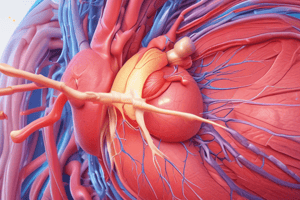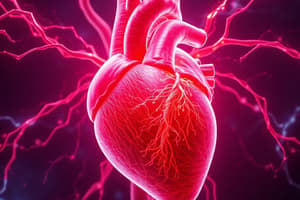Podcast
Questions and Answers
What is the pericardium?
What is the pericardium?
A double-walled sac that encloses the heart and isolates it from other organs.
Which of the following is a cause of pericarditis? (Select all that apply)
Which of the following is a cause of pericarditis? (Select all that apply)
- Trauma to the chest (correct)
- Heart attack (correct)
- Lung disease
- Infection (correct)
The heart operates on its own.
The heart operates on its own.
True (A)
What are intercalated discs?
What are intercalated discs?
The resting membrane potential of cardiac muscle is between _____ millivolts.
The resting membrane potential of cardiac muscle is between _____ millivolts.
What happens during phase 0 of the ventricular muscle action potential?
What happens during phase 0 of the ventricular muscle action potential?
The fibrous insulator exists between which parts of the heart?
The fibrous insulator exists between which parts of the heart?
What is the purpose of the pericardial fluid?
What is the purpose of the pericardial fluid?
Study Notes
Heart Location and Associated Structures
- The heart is located in the thoracic cavity, enclosed by various structures.
- The pericardium is a double-walled sac surrounding the heart, preventing friction during beats and allowing expansion while resisting excessive stretching.
- It is anchored inferiorly to the diaphragm and anteriorly to the sternum.
The Pericardium
- The pericardium has two main layers:
- Parietal pericardium: The outer layer with a fibrous layer providing strength and a serous layer for lubrication.
- Visceral pericardium (epicardium): A serous lining covering the heart directly.
- The pericardial cavity contains 5 to 30 mL of pericardial fluid, aiding in smooth heart movement.
Pericarditis
- Pericarditis refers to the inflammation of the pericardium, often resulting from infections, heart attacks, trauma, or radiation.
- Symptoms include chest pain and potential difficulty in heart function.
- Common treatments involve NSAIDs, antibiotics, or pericardiocentesis to relieve pressure.
Cardiac Muscle Structure
- Cardiac muscle is composed of smaller cells (cardiac fibers) with a single nucleus and interconnected via intercalated discs.
- Intercalated discs facilitate the mechanical and electrical connection between cardiac cells, featuring:
- Desmosomes: Mechanically link neighboring cells.
- Gap Junctions: Allow electrical impulses to propagate rapidly.
Function of Cardiac Muscle
- Cardiac muscle operates autonomously; contractions are triggered by electrical impulses generated within the heart.
- Each contraction is an "all or none" event, due to the syncytial nature of the muscle, meaning all connected cells contract fully.
- The atria and ventricles contract as separate functional syncytia due to a fibrous insulator that separates them.
Action Potentials in Cardiac Muscle
- Resting membrane potential of cardiac muscle cells ranges from -85 to -95 mV.
- Action potential peaks at approximately +105 mV, distinguished by a prolonged plateau lasting around 0.2-0.3 seconds—significantly longer than in skeletal muscle.
- Cardiac muscle action potential phases include:
- Phase 0: Fast sodium channels open, leading to depolarization.
- Phase 1: Potassium channels open, initiating repolarization.
Key Physiological Concepts
- The heart's conduction system is crucial for synchronizing contractions.
- Cardiac muscle cells are rich in mitochondria and myoglobin, enabling high energy demands during pumping cycles.
- The coordinated contraction and relaxation of the heart are essential for effective circulation throughout the body.
Studying That Suits You
Use AI to generate personalized quizzes and flashcards to suit your learning preferences.
Related Documents
Description
This quiz focuses on the structure and function of cardiac muscle and how the heart operates as a pump. It is designed for students in the Masters of Medical Sciences program at LECOM-Bradenton. Assess your understanding of cardiology concepts, including the pericardium and associated structures.




